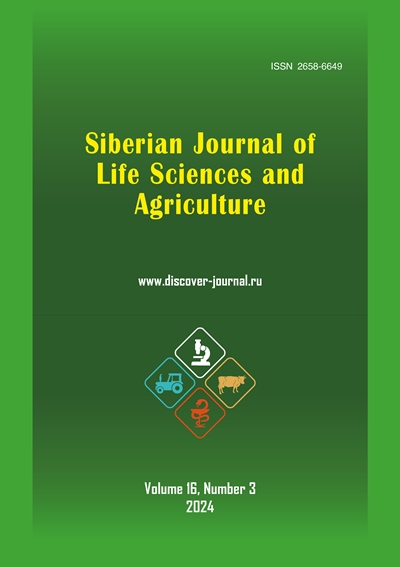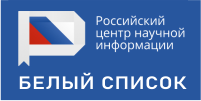ОЦЕНКА ВЛИЯНИЯ АУКСИНОВ НА РОСТ И БИОХИМИЧЕСКИЕ ПОКАЗАТЕЛИ CHAETOCEROS MUELLERI
Аннотация
Обоснование. Изучение процесса культивирования микроводорослей связанно не только с получением широкого спектра биологически активных веществ. С развитием марикультуры некоторые виды микроводорослей (в том числе Chaetoceros muelleri), представляют интерес в качестве кормов для таких объектов культивирования как моллюски, членистоногие и голотурии. Целью данного исследования являлась оценка влияния гормонов ауксинового ряда на количественные и качественные показатели микроводоросли Chaetoceros muelleri.
Материалы и методы. Объектом исследований являлась культура микроводорослей Chaetoceros muelleri. Продолжительность эксперимента составляла 7 дней. Для стимуляции роста использовали индолил-3-масляную кислоту и индол-3-уксусную кислоты. Культивирование микроводоросли осуществлялось в монокультуре, при постоянных условиях. К экспериментальной группе добавляли указанные фитогормоны в концентрации 0,1; 0,2; 0,4; 0,6; 1,0 × 10-5моль. Контрольная группа культивировалась без добавления фитогормонов.
Результаты исследований. Показано, что 3 индол уксусная кислота в концентрациях от 0,2 до 0,5×10-5моль оказывала положительное влияние на рост культуры водорослей. При использовании обоих гормонов в оптимальной концентрации установлен выраженный положительный эффект накопления липидов в культуре водоросли. Установлено, что индолил-3-масляная кислота в оптимальной концентрации повышала содержание углеводов в культуре.
Заключение. Полученные данные показали, что исследованные фитогормоны оказывали положительное влияние на динамику роста микроводоросли Chaetoceros muelleri в накопительной культуре. Проведенное исследование показало возможность использования исследованных фитогормонов ауксинового ряда для стимуляции роста микроводоросли Chaetoceros muelleri в накопительной монокультуре.
Скачивания
Литература
Список литературы
Киселева А.А., Тараховская Е.Р., Шишова М.Ф. Биосинтез фитогормонов у водорослей // Физиология растений. 2012. № 59. С. 643-659.
Романенко Е. А., Косаковская И. В., Романенко П. А. Фитогормоны микроводорослей: биологическая роль и участие в регуляции физиологических процессов. Ч. I. Ауксины, абсцизовая кислота, этилен // Альгология. 2015. Т. 25. № 3. С. 330–351.
Aminot A., Ray F. Standard procedure for the determination of chlorophyll a by spectroscopic methods. ICES techniques in marine environmental sciences // International Council for the Exploration of the Sea. 2001. 16 p.
Bajguz A., Piotrowska-Niczyporuk A. Synergistic effect of auxins and brassinosteroids on the growth and regulation of metabolite content in the green alga Chlorella vulgaris (Trebouxiophyceae) // Plant Physiology and Biochemistry. 2013. Vol. 71. P. 290-297.
Berard-Therriault L., Poulin M., Bosse L. Guide d'identification du phytoplancton marin de l'estuaire et du golfe du Saint-Laurent: incluant egalement certains protozoaires // Canadian Science Publishing (NRC Research Press) . 1999. 387 p.
Сarneiro M., Pojo V., Malcata F.X., Otero A. Lipid accumulation in selected Tetraselmis strains // Journal of Applied Phycology. 2019. Vol. 31. № 5. P. 2845-2853.
Chen B., Wan C., Mehmood M.A., Chang J.S., Bai F., Zhao X. Manipulating environmental stresses and stress tolerance of microalgae for enhanced production of lipids and value-added products; a review // Bioresource Technology. 2017. Vol. 244. P. 1198-1206.
Czerpak R., Bajguz A. Stimulatory effect of auxins and cytokinins on carotenes, with differential effects on xanthophylls in the green alga Chlorella pyrenoidosa Chick // Acta Societatis Botanicorum Poloniae. 1997. Vol. 66. P. 41-46.
Fazal T., Mushtaq A., Rehman F., Khan A.U., Rashid N., Farooq W., Xu J. Bioremediation of textile wastewater and successive biodiesel production using microalgae // Renewable & Sustainable Energy Reviews. 2018. Vol. 82. P. 3107-3126.
Gonzalez-Garcinu A., Sanchez-Alvarez J.A., Martin del Valle E.M. Understanding and optimizing the addition of phytohormones in the culture of microalgae for lipid production // Biotechnology Progress. 2016, Vol. 32. № 5. P. 1203-1221.
Guillard, R.R.L. Culture of Phytoplankton for Feeding Marine Invertebrates. In: Smith, M.L. and Chanley, M.H., Eds., Culture of Marine Invertebrates Animals, Plenum Press, New York, 1975. P. 29-60.
Hadizadeh Z., Mehrgan M.S., Shekarabi S.P.H. The potential use of stickwater from a kilka fishmeal plant in Dunaliella salina cultivation // Environmental Science and Pollution Research. 2020. Vol. 27. P. 2144-2154.
Han S.F., Jin W., Abomohra A.E.F., Zhou X., Tu R., Chen C., Wang Q. Enhancement of lipid production of Scenedesmus obliquus cultivated in municipal wastewater by plant growth regulator treatment // Waste Biomass Valorization. 2019. Vol. 10. P. 2479-2485.
Herbert D., Phipps P. J., Strange R. E. Chemical analysis of microbial cells // Methods in Microbiology. 1971. № 5. P. 209-344.
Johnson K.R., Ellis G., Toothill C. The sulfophosphovanilin reaction for serum lipids: a reappraisal // Clinical Chemistry. 1977. Vol. 23. P. 1669-1673.
Kawamura T., Roberts R.D., Nicholson C.M. Factors affecting the food value of diatom strains for post-larval abalone Haliotis iris // Aquaculture. 1998. Vol. 160. P. 81-88.
Kobraei M.E., White D.S. Effects of 2,4-dichlorophenoxyacetic acid on Kentucky Algae: simultaneous laboratory and field toxicity testings // Arch. Environ. Contam. Toxicol. 1996. Vol. 31. P.571-580.
Koyande A.K., Chew K.W., Rambabu K., Tao Y., Chu D.T., Show P.L. Microalgae: A potential alternative to health supplementation for humans // Food Science and Human Wellness. 2019. Vol. 8. P. 16-24.
Kozlova T.A., Hardy B.P., Krishna P. & Levin D.B. Effect of phytohormones on growth and accumulation of pigments and fatty acids in the microalgae Scenedesmus quadricauda // Algal Research. 2017. Vol. 27. P. 325-334.
Laurens L.M.L., Dempster T.A., Jones H.D. T., Wolfrum E.J., Wychen S.V., McAllister J.S.P., Rencenberger M., Parchert K.J., Gloe L.M. Algal Biomass Constituent Analysis: Method Uncertainties and Investigation of the Underlying Measuring Chemistries // Journal of Analytical Chemistry. 2012. Vol. 84. № 4. P. 1879-1887.
Lin B., Ahmed F., Du H., Li Z., Yan Y., Huang Y., Meng C. Plant growth regulators promote lipid and carotenoid accumulation in Chlorella vulgaris // Journal Applied Phycology. 2018. Vol. 30. P. 1549-1561.
Lowry O., Rosenbrougt N., Parr A., Randall R. Protein measurement with the Folin phenol reagent // Journal of Biological Chemistry. 1951. Vol. 193. № 1. P. 265-276.
Lu Y., Xu J. Phytohormones in microalgae: a new opportunity for microalgal biotechnology? // Trends in Plant Science. 2015. Vol. 20. P. 272-283.
Measuring Growth Rates in Microalgal Cultures / Wood A. M., Everroad R. C., Wingard L. M. // Algal Culturing Technique [Andersen R.A.]. New York: Elsevier Academic Press. 2005. P. 269-285.
Paliwal C., Mitra M., Bhayani K., Bharadwaj S.V., Ghosh T., Dubey S., Mishra S. Abiotic stresses as tools for metabolites in microalgae // Bioresource Technology. 2017. Vol. 244. P. 1216-1226.
Park W-K., Yoo G., Moon M., Kim C.W., Choi Y-E., Yang J-W. Phytohormone supplementation significantly increases growth of Chlamydomonas reinhardtii cultivated for biodiesel production // Appl. Biochem. Biotechnol. 2013. Vol. 171. P. 1128-1142.
Rastar M., Hosseini S.P., Shamsaie M.S., Sabzi S. Effects of iron and zinc concentrations on growth performance and biochemical composition of Haematococcus pluvialis: a comparison between nanoparticles and their corresponding metals bulks // Journal of Algal Biomass Utilization. 2018. Vol. 9. P. 59–67.
Renuka N., Guldhe A., Prasanna R., Singh P., Bux F. Microalgae as multi-functional options in modern agriculture: current trends, prospects and challenges // Biotechnology Advances. 2018. Vol. 36. P. 1255-1273.
Rines J.E.B., Theriot E.C. Systematics of Chaetocerotaceae (Bacillariophyceae): I. A phylogenetic analysis of the family // Physiol. Res. 2003. Vol. 51. № 2. P. 83-98.
Rizwan M., Mujtaba G., Memon S.A., Lee K., Rashid N. Exploring the potential of microalgae for new biotechnology applications and beyond: a review // Renewable Sustainable Energy Reviews. 2018. Vol. 92. P. 394-404.
Sabzi S., Mehrgan M.S., Islami H.R., Shekarabi S.P.H. Changes in biochemical composition and fatty acid accumulation of Nannochloropsis oculata in response to different iron concentrations // Biofuels. 2018. Vol. 12. P. 1-7.
Salama E-S., Kabra A.N., Ji M-K., Kim J.R., Min B., Jeon B-H. Enhancement of microalgae growth and fatty acid content under the influence of phytohormones // Bioresource Technology. 2014. Vol. 172. P. 97-103.
Webb K., Chu F.L. Phytoplankton as a food source for algae. In: Pruder G.D., Langdon C.J., Conklin D.E. (eds) // Proc. 2nd Int. Conf. Aquacult. Nutr. Spec. // Publ. No 2. Louisiana State University, Baton Rouge, LA. 1983. P. 272-291.
Zhao Y., Wang H.P., Han B., Yu X. Coupling of abiotic stresses and phytohormones for the production of lipids and high-value by-products by microalgae: a review // Bioresource Technology. 2019. Vol. 274. P. 549-556.
Zhuang L.L., Yu D., Zhang J., Liu F.F., Wu Y.H., Zhang T.Y., Hu H.Y. The characteristics and influencing factors of the attached microalgae cultivation: a review // Renewable and Sustainable Energy Reviews. 2018. Vol. 94. P. 1110-1119.
Zienkiewicz K., Du Z.Y., Ma W., Vollheyde K., Benning C. Stress-induced neutral lipid biosynthesis in microalgae-molecular, cellular and physiological insights // Biochimica et Biophysica Acta. 2016. Vol. 1861. P. 1269-1281.
References
Kiseleva A.A., Tarahovskaya E.R., Shishova M.F. Biosintez fitogormonov u vodorosle [Biosynthesis of phytohormones in algae]. Fiziologiya rastenij, 2012, no. 59, pp. 643-659.
Romanenko E.A., Kosakovskaya I.V., Romanenko P.A. Fitogormony mikrovodoroslej: biologicheskaya rol' i uchastie v regulyacii fiziologicheskih processov. Ch. I. Auksiny, abscizovaya kislota, etilen [Microalgae phytohormones: biological role and participation in the regulation of physiological processes. Part I. Auxins, abscisic acid, ethylene]. Al'gologiya, 2015, vol. 25, no. 3, pp. 330-351.
Aminot A., Ray F. Standard procedure for the determination of chlorophyll a by spectroscopic methods. ICES techniques in marine environmental sciences. International Council for the Exploration of the Sea, 2001, 16 p.
Bajguz A., Piotrowska-Niczyporuk A. Synergistic effect of auxins and brassinosteroids on the growth and regulation of metabolite content in the green alga Chlorella vulgaris (Trebouxiophyceae). Plant Physiology and Biochemistry, 2013, vol. 71, pp. 290-297.
Berard-Therriault L., Poulin M., Bosse L. Guide d'identification du phytoplancton marin de l'estuaire et du golfe du Saint-Laurent: incluant egalement certains protozoaires. Canadian Science Publishing (NRC Research Press) . 1999, 387 p.
Сarneiro M., Pojo V., Malcata F.X., Otero A. Lipid accumulation in selected Tetraselmis strains. Journal of Applied Phycology, 2019, vol. 31, no. 5, pp. 2845-2853.
Chen B., Wan C., Mehmood M.A., Chang J.S., Bai F., Zhao X. Manipulating environmental stresses and stress tolerance of microalgae for enhanced production of lipids and value-added products; a review. Bioresource Technology, 2017, vol. 244, pp. 1198-1206.
Czerpak R., Bajguz A. Stimulatory effect of auxins and cytokinins on carotenes, with differential effects on xanthophylls in the green alga Chlorella pyrenoidosa Chick. Acta Societatis Botanicorum Poloniae, 1997, vol. 66, pp. 41-46.
Fazal T., Mushtaq A., Rehman F., Khan A.U., Rashid N., Farooq W., Xu J. Bioremediation of textile wastewater and successive biodiesel production using microalgae. Renewable & Sustainable Energy Reviews, 2018, vol. 82, pp. 3107-3126.
Gonzalez-Garcinu A., Sanchez-Alvarez J.A., Martin del Valle E.M. Understanding and optimizing the addition of phytohormones in the culture of microalgae for lipid production. Biotechnology Progress, 2016, vol. 32, no. 5, pp. 1203-1221.
Guillard, R.R.L. Culture of Phytoplankton for Feeding Marine Invertebrates. In: Smith, M.L. and Chanley, M.H., Eds., Culture of Marine Invertebrates Animals, Plenum Press, New York, 1975, pp. 29-60.
Hadizadeh Z., Mehrgan M.S., Shekarabi S.P.H. The potential use of stickwater from a kilka fishmeal plant in Dunaliella salina cultivation. Environmental Science and Pollution Research, 2020, vol. 27, pp. 2144-2154.
Han S.F., Jin W., Abomohra A.E.F., Zhou X., Tu R., Chen C., Wang Q. Enhancement of lipid production of Scenedesmus obliquus cultivated in municipal wastewater by plant growth regulator treatment. Waste Biomass Valorization, 2019, vol. 10, pp. 2479-2485.
Herbert D., Phipps P. J., Strange R. E. Chemical analysis of microbial cells. Methods in Microbiology, 1971, no. 5, pp. 209-344.
Johnson K.R., Ellis G., Toothill C. The sulfophosphovanilin reaction for serum lipids: a reappraisal. Clinical Chemistry, 1977, vol. 23, pp. 1669-1673.
Kawamura T., Roberts R.D., Nicholson C.M. Factors affecting the food value of diatom strains for post-larval abalone Haliotis iris. Aquaculture, 1998, vol. 160, pp. 81-88.
Kobraei M.E., White D.S. Effects of 2,4-dichlorophenoxyacetic acid on Kentucky Algae: simultaneous laboratory and field toxicity testings. Arch. Environ. Contam. Toxicol., 1996, vol. 31, pp. 571-580.
Koyande A.K., Chew K.W., Rambabu K., Tao Y., Chu D.T., Show P.L. Microalgae: A potential alternative to health supplementation for humans. Food Science and Human Wellness, 2019, vol. 8, pp. 16-24.
Kozlova T.A., Hardy B.P., Krishna P. & Levin D.B. Effect of phytohormones on growth and accumulation of pigments and fatty acids in the microalgae Scenedesmus quadricauda. Algal Research, 2017, vol. 27, pp. 325-334.
Laurens L.M.L., Dempster T.A., Jones H.D.T., Wolfrum E.J., Wychen S.V., McAllister J.S.P., Rencenberger M., Parchert K.J., Gloe L.M. Algal Biomass Constituent Analysis: Method Uncertainties and Investigation of the Underlying Measuring Chemistries. Journal of Analytical Chemistry, 2012, vol. 84, no. 4, pp. 1879-1887.
Lin B., Ahmed F., Du H., Li Z., Yan Y., Huang Y., Meng C. Plant growth regulators promote lipid and carotenoid accumulation in Chlorella vulgaris. Journal Applied Phycology, 2018, vol. 30, pp. 1549-1561.
Lowry O., Rosenbrougt N., Parr A., Randall R. Protein measurement with the Folin phenol reagent. Journal of Biological Chemistry, 1951, vol. 193, no. 1, pp. 265-276.
Lu Y., Xu J. Phytohormones in microalgae: a new opportunity for microalgal biotechnology? Trends in Plant Science, 2015, vol. 20, pp. 272-283.
Measuring Growth Rates in Microalgal Cultures. A. M. Wood, R.C. Everroad, L.M. Wingard. Algal Culturing Technique [Andersen R.A.]. New York: Elsevier Academic Press, 2005, pp. 269-285.
Paliwal C., Mitra M., Bhayani K., Bharadwaj S.V., Ghosh T., Dubey S., Mishra S. Abiotic stresses as tools for metabolites in microalgae. Bioresource Technology, 2017, vol. 244, pp. 1216-1226.
Park W-K., Yoo G., Moon M., Kim C.W., Choi Y-E., Yang J-W. Phytohormone supplementation significantly increases growth of Chlamydomonas reinhardtii cultivated for biodiesel production. Appl. Biochem. Biotechnol., 2013, vol. 171, pp. 1128-1142.
Rastar M., Hosseini S.P., Shamsaie M.S., Sabzi S. Effects of iron and zinc concentrations on growth performance and biochemical composition of Haematococcus pluvialis: a comparison between nanoparticles and their corresponding metals bulks. Journal of Algal Biomass Utilization, 2018, vol. 9, pp. 59-67.
Renuka N., Guldhe A., Prasanna R., Singh P., Bux F. Microalgae as multi-functional options in modern agriculture: current trends, prospects and challenges. Biotechnology Advances, 2018, vol. 36, pp. 1255-1273.
Rines J.E.B., Theriot E.C. Systematics of Chaetocerotaceae (Bacillariophyceae): I. A phylogenetic analysis of the family. Physiol. Res., 2003, vol. 51, no. 2, pp. 83-98.
Rizwan M., Mujtaba G., Memon S.A., Lee K., Rashid N. Exploring the potential of microalgae for new biotechnology applications and beyond: a review. Renewable Sustainable Energy Reviews, 2018, vol. 92, pp. 394-404.
Sabzi S., Mehrgan M.S., Islami H.R., Shekarabi S.P.H. Changes in biochemical composition and fatty acid accumulation of Nannochloropsis oculata in response to different iron concentrations. Biofuels, 2018, vol. 12, pp. 1-7.
Salama E-S., Kabra A.N., Ji M-K., Kim J.R., Min B., Jeon B-H. Enhancement of microalgae growth and fatty acid content under the influence of phytohormones. Bioresource Technology, 2014, vol. 172, pp. 97-103.
Webb K., Chu F.L. Phytoplankton as a food source for algae. In: Pruder G.D., Langdon C.J., Conklin D.E. (eds). Proc. 2nd Int. Conf. Aquacult. Nutr. Spec. Publ. no 2. Louisiana State University, Baton Rouge, LA, 1983, pp. 272-291.
Zhao Y., Wang H.P., Han B., Yu X. Coupling of abiotic stresses and phytohormones for the production of lipids and high-value by-products by microalgae: a review. Bioresource Technology, 2019, vol. 274, pp. 549-556.
Zhuang L.L., Yu D., Zhang J., Liu F.F., Wu Y.H., Zhang T.Y., Hu H.Y. The characteristics and influencing factors of the attached microalgae cultivation: a review. Renewable and Sustainable Energy Reviews, 2018, vol. 94, pp. 1110-1119.
Zienkiewicz K., Du Z.Y., Ma W., Vollheyde K., Benning C. Stress-induced neutral lipid biosynthesis in microalgae-molecular, cellular and physiological insights. Biochimica et Biophysica Acta, 2016, vol. 1861, pp. 1269-1281.
Просмотров аннотации: 260 Загрузок PDF: 122
Copyright (c) 2024 Nickolay N. Kovalev, Svetlana Е. Leskova, Evgeny V. Mikheev, Ekaterina A. Barsova

Это произведение доступно по лицензии Creative Commons «Attribution-NonCommercial-NoDerivatives» («Атрибуция — Некоммерческое использование — Без производных произведений») 4.0 Всемирная.






















































